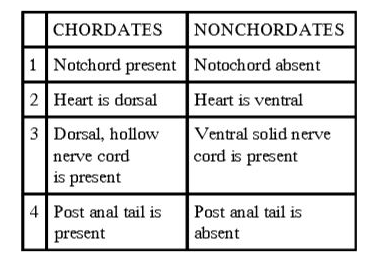Give three major differences between chordates and non chordates and draw a schematic sketch of a chordate showing those features.
Step-by-Step Solution:
Step 1: Define Chordates and Non-Chordates
- Chordates are animals that possess a notochord at some stage of their development, along with other specific features.
- Non-chordates are animals that do not have a notochord and lack other characteristics typical of chordates.
Step 2: Identify Three Major Differences
1. Presence of Notochord:
- Chordates: Have a notochord.
- Non-Chordates: Do not have a notochord.
2. Central Nervous System:
- Chordates: The central nervous system is dorsal (located on the back), hollow, and single.
- Non-Chordates: The central nervous system is ventral (located on the belly), solid, and double.
3. Pharynx and Gill Slits:
- Chordates: The pharynx is perforated by gill slits.
- Non-Chordates: The pharynx does not have gill slits.
Step 3: Draw a Schematic Sketch of a Chordate
- In the sketch, include the following features:
- Notochord: A flexible rod-like structure running along the body.
- Dorsal Hollow Nerve Cord: A tube-like structure located above the notochord.
- Gill Slits: Openings in the pharyngeal region.
- Post-Anal Tail: An extension of the body beyond the anus.
Schematic Sketch of a Chordate:
1. Draw a horizontal line representing the body.
2. Above this line, draw a tube to represent the dorsal hollow nerve cord.
3. Below the line, draw a rod to represent the notochord.
4. On the sides of the pharyngeal region, draw slits to represent the gill slits.
5. Extend a tail from the posterior end of the body to represent the post-anal tail.
- Chordates are animals that possess a notochord at some stage of their development, along with other specific features.
- Non-chordates are animals that do not have a notochord and lack other characteristics typical of chordates.
1. Presence of Notochord:
- Chordates: Have a notochord.
- Non-Chordates: Do not have a notochord.
- Chordates: The central nervous system is dorsal (located on the back), hollow, and single.
- Non-Chordates: The central nervous system is ventral (located on the belly), solid, and double.
- Chordates: The pharynx is perforated by gill slits.
- Non-Chordates: The pharynx does not have gill slits.
- In the sketch, include the following features:
- Notochord: A flexible rod-like structure running along the body.
- Dorsal Hollow Nerve Cord: A tube-like structure located above the notochord.
- Gill Slits: Openings in the pharyngeal region.
- Post-Anal Tail: An extension of the body beyond the anus.
1. Draw a horizontal line representing the body.
2. Above this line, draw a tube to represent the dorsal hollow nerve cord.
3. Below the line, draw a rod to represent the notochord.
4. On the sides of the pharyngeal region, draw slits to represent the gill slits.
5. Extend a tail from the posterior end of the body to represent the post-anal tail.
Topper's Solved these Questions
- ANIMAL KINGDOMBook:NCERT EXEMPLAR ENGLISHChapter:ANIMAL KINGDOMExercise:SHORT ANSWER TYPE QUESTIONS
Explore 13 Videos
- ANATOMY OF FLOWERING PLANTSBook:NCERT EXEMPLAR ENGLISHChapter:ANATOMY OF FLOWERING PLANTSExercise:Long Answer
Explore 6 Videos
- BIOLOGICAL CLASSIFICATIONBook:NCERT EXEMPLAR ENGLISHChapter:BIOLOGICAL CLASSIFICATIONExercise:Long answer
Explore 5 Videos
Similar Questions
Differentiate between Chordates and non-chordates
View SolutionGive three differences between metals and non-metals.
View SolutionGive three differences between antibodies and interferons .
View SolutionConnecting link between chordates and non-chordates is
View SolutionDifferentiate between Chordates and vertebrates
View SolutionGive any three differences between an artery and a vein.
View SolutionWhat are the major differences between metals and non-metals?
View SolutionEnumerate any three major differences between humans and apes.
View SolutionGive three structural differences between a frog and a lizard.
View SolutionFind out the wrong difference between chordates and nonchordates from the table given below :-

View Solution

